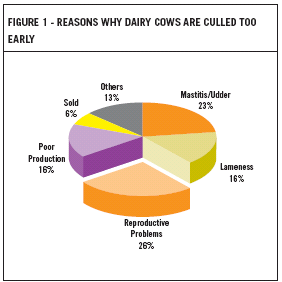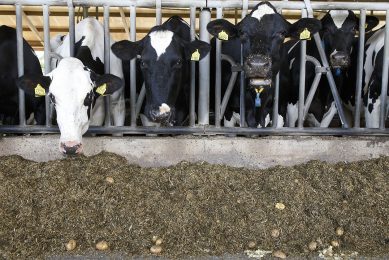ß-carotene and cow reproductive performance

Fertility and reproductive performance are crucial to the profitability of dairy herds. One key factor that substantially improves fertility and reproductive performance is the dietary intake of ß-carotene. By Irmgard Immig.
By: Irmgard Immig
Dairy herd size has seen a steady growth over the past 30 years which coincided with an increase in average milk yields. This increased productivity has brought with it the negative trend of higher culling rates caused to a great extent by reproductive problems. USDA results from 2007 (Figure 1) show that 26% of cows leaving herds too early in their life are culled for this reason, in particular due to a failure to rebreed after conception. Longer calving intervals and high herd replacement rates are major economic threats that negatively affect the dairy farmer’s monthly bottom line. Normally, a cow should calve once per year and the herd replacement rate should not exceed 30%. Yet calving intervals of more than 420 days and replacement rates as high as 45% are reported in modern dairy herds. Calving interval and parity are major profitability factors in milk production. Cows with long calving intervals spend more time in late lactation when daily milk yield can be below 18 kg. Where calving intervals are shorter, a larger proportion of the lactation is in early lactation where daily milk yield is above 30 kg.
As for the importance of parity, older cows give up to 20% more milk than first lactation milkers (Figure 2). Table 1 shows that reducing calving interval in a herd of 100 cows from 420 to 365 days can increase annual milk sales by more than €11,000 and that rearing fewer heifers as herd replacements can further increase total revenue: simple calculations emphasising the importance of getting cows back into calf as early as possible and optimising cow/heifer ratio. Both factors are prerequisites for optimum herd structure to generate the highest revenues and this in turn means that improving pregnancy rates early-on in lactation is always worthwhile – even under the situation of a tight budget and cash flow.
Symptoms of deficiency
It’s well documented that cows deficient in ß-carotene have impaired reproductive performance (Meyer et al. (1975) and Lotthammer et al. (1975, 1978), Arechiga, 1998). Symptoms may include weak or silent oestrus, delayed ovulation, ovarian cysts, abnormally high embryonic mortality or retained placenta. This means there’s inevitably sub-optimal fertility in herds with low ß-carotene status. The knowledge of a cow‘s ß-carotene status for her subsequent reproductive performance is therefore key. Nowadays the ß-carotene status of a herd can be easily quantified using a rapid ß-carotene extraction method from whole blood and a hand-held spectrophotometer. This cow side technology which is now widely used by the global dairy industry provides immediate results of ß-carotene levels so that a targeted ß-carotene supplementation can be put in to place the same day. However, not only the dosage but also the source of ß-carotene plays a crucial role as ß-carotene sources are not the same. Besides stability in the feed supplement a high bioavailablity is of prime importance for optimum ß-carotene levels in the ovaries and in the colostrum.
Follicle production
In a recently conducted trial at Obihiro University in Japan ß-carotene plasma levels were profiled with 22 multiparous cows from three weeks prepartum until three weeks postpartum (Kawashima et al. 2008). Ovulating cows were confirmed by blood progesterone levels and ultrasonic scans. The researchers demonstrated that ß-carotene plasma levels before calving determine when cows produce the first dominant follicle after calving. Irrespective of post-calving plasma levels cows with a higher concentration of plasma ß-carotene in the last three weeks of the dry period were ovulatory whilst those with a lower status were an-ovulatory (Figure 3). ß-carotene status before calving is also a key factor for enrichment of colostrum thus influencing the vitality of the newborn calf (Figure 4). It can therefore be concluded that cows with higher ß-carotene status resume ovulation faster than cows with low ß-carotene levels. This demonstrates clearly the importance of high ß-carotene levels prior to the onset of the reproductive cycle after calving.
| | |
Confirmation trials
In a survey recently conducted of intensively-managed dairy herds in countries including the US, France, Italy, Germany, Israel, Japan, Korea and Mexico it was found that the majority of cows did not exceed ß-carotene levels of 2.5 µg/ml plasma. In most countries 75% of cows had marginal plasma ß-carotene levels and as much as 30% of cows were deficient. All herds tested were also reporting reproductive problems with long calving intervals of up to 450 days and high replacement rates of up to 45% (Figure 5). A trial conducted in such a ß-carotene deficient herd showed that targeted supplementation with a ß-carotene supplement* alleviated the drop in plasma ß-carotene status before calving (Figure 6) (Bian et al., 2007). Abortions decreased from 10% to zero and cows resumed cyclic activity 3-8 days faster than those without being supplemented. All effects were more pronounced in those cows on the higher plane of supplementation. These results confirm once again the findings of the University of Florida from 1998 and of Lotthammer et al. (1975 and 1978 data not shown) that cows supplemented with ß-carotene had less reproductive disorders. The pregnancy rate after 120 post partum was nearly doubled compared to the control group (Table 2).
Another field trial was conducted in a well-managed commercial dairy herd in the US to determine the effect of a ß-carotene supplement* in the diets of high-production cows with marginal plasma ß-carotene status. The influence on milk production, milk components, feed intake and reproduction were recorded. Half the cows received the supplement and half did not. The basic ration consisted of maize silage, lucerne/grass haylage, high-moisture shelled maize and a commercial feed mix. The results of the trial are summarised in Table 3.
Return on investment
It was shown that the cows fed diets with the supplement increased their plasma ß-carotene levels from deficient to optimum. This increased milk fat percentage resulting in more 3.5% fat corrected milk (FCM). Pregnancy rate was doubled, calving interval reduced by 30 days and abortions were almost halved. The value of an additional 1% increase in pregnancy rate is estimated at €16/cow, the costs of abortions are estimated at €363 per case and milk price is taken as €0.22/kg per kg of 3.5% FCM. Considering the price of the supplement used in this trail at about €2,000 per 100 cows, the revenue increase exceeded €20,000 which is a return on investment of 10:1. Even a further reduction of 50% in milk price would still generate a good return on investment.
Conclusion
In conclusion, ß-carotene supplementation improves reproductive performance in ß-carotene deficient cows. Cows with plasma ß-carotene levels below 1.5 µg/ml require ß-carotene supplementation of at least 500 mg per head per day. Cows with plasma ß-carotene levels between 1.5 and 3.5 µg/ml need 300 mg ß-carotene per head per day**. Supplementation should start with the beginning of the dry period through to confirmation of the next pregnancy. <-
*ROVIMIX® ß-Carotene. This feed supplement can be coupled to a newly developed rapid iCheck® diagnostic tool for assessing a herd’s ß-carotene status
** As recommended by DSM
About the author:
Dr. Irmgard Immig is the global marketing manager ruminants within the department Animal Nutrition and Health at DSM Nutritional Products. Immig is based at the headquarters in Switzerland.
Source: Feed Mix magazine Vol 17 nr 5 (2009)











